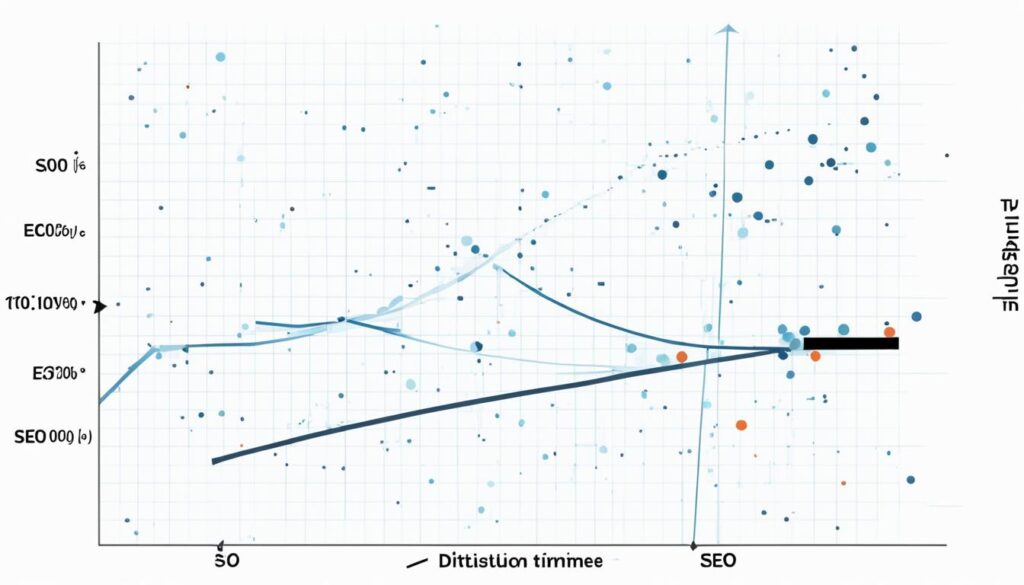When it comes to creating SEO articles, choosing the right format is essential for maximizing visibility and engagement. As an SEO writer, I know that the format of an article can greatly impact its success in search engine rankings. In this section, I will provide you with valuable insights on how to format SEO articles effectively.
Key Takeaways:
- Choosing the right format is crucial for SEO article success.
- A well-structured article increases visibility and engagement.
- Use subheadings to enhance readability and user experience.
- Incorporate primary and secondary keywords naturally throughout the content.
- Create high-quality and valuable content for readers.
Understanding the Importance of SEO Writing
When it comes to getting your content noticed online, SEO writing plays a crucial role. By optimizing your content for search engines, you can reach more people who are actively searching for the information you have to offer.
SEO writing is all about increasing your visibility on search engines like Google. By following best practices and incorporating relevant keywords into your content, you increase the chances of your content being discovered by the right audience. This can lead to a significant boost in organic traffic and enhance your overall online presence.
Without SEO writing, your valuable content might go unnoticed by search engine users, no matter how high-quality or informative it is. SEO serves as a bridge between search engine users and the information they seek, helping them find your content easily and efficiently.
So why is SEO writing so important? Let’s take a closer look at the benefits:
- Reach more people: By optimizing your content for search engines, you can expand your reach and connect with a larger audience who are actively looking for the topics you cover.
- Increase visibility on search engines: When you incorporate SEO techniques, your content has a higher chance of appearing in search engine results pages, making it more visible to potential readers.
- Improve organic traffic: By increasing your visibility on search engines, you can attract more organic traffic to your website, leading to more engagement, conversions, and potential business growth.
- Enhance online presence: SEO writing helps establish credibility and authority for your brand or website, making it stand out among the vast competition online.
To truly optimize your content for search engines, it’s important to understand the key techniques and strategies involved in SEO writing. By following these best practices, you can ensure that your content is not only valuable and informative but also optimized for maximum visibility and reach.
Next, we’ll explore some valuable tips for creating SEO-optimized content, including how to find the right keywords, choose the best content format, create high-quality content, and structure your content for optimal search engine visibility.
Quote of the Section:
“SEO writing is like a compass that guides your content to the right audience, helping you connect with those who are actively seeking your expertise.”
Tips for Creating SEO-Optimized Content
When it comes to creating SEO-optimized content, there are several key tips that can help you maximize your efforts and improve your rankings in search engine results.
Finding the Primary Keyword
The first step in creating SEO-optimized content is finding a primary keyword that reflects the main topic of your content. This keyword should have relevance to your target audience and align with their search intent. Utilize keyword research tools to identify keywords with adequate search volume and ranking difficulty.
Choosing Secondary Keywords
In addition to the primary keyword, it’s beneficial to choose related secondary keywords that broaden the reach of your content. These keywords can help you capture a wider audience and increase the visibility of your content on search engines.
Content Format for SEO
The content format you choose plays a crucial role in the success of your SEO efforts. Different formats cater to different search intents. Consider common content formats like how-to guides, list posts, or step-by-step tutorials, depending on the nature of your content and the preferences of your target audience.
Create Quality Content
High-quality content that provides value to your audience is essential for SEO success. Focus on delivering informative, engaging, and well-researched content that addresses the needs and interests of your target audience.
Leverage Keywords in Your Content
While incorporating keywords naturally throughout your content, remember not to overdo it or engage in keyword stuffing. Instead, aim for a balanced integration of keywords that enhances the readability and flow of your content.
Structure Content with Subheadings
Structuring your content with subheadings not only improves readability but also helps search engines understand the organization and hierarchy of your content. Use descriptive and relevant subheadings to break down your content into digestible sections.
By following these tips, you can create SEO-optimized content that attracts organic traffic, improves your search engine rankings, and provides value to your audience.
Optimizing SEO Content for Search Engines

Once the content format is chosen, it’s crucial to optimize it for search engines. This involves incorporating relevant keywords in strategic locations, such as the title, abstract, headings, and other elements of the content. The keywords should seamlessly blend into the text and provide value to the reader, rather than appearing forced or repetitive.
Optimizing content for search engines also means optimizing it for user experience. Clear, concise, and readable content is not only beneficial for users but also increases the chances of higher search engine rankings. Users should be able to easily understand the message and take action, whether it’s making a purchase, submitting a form, or engaging in any other desired behavior.
Providing Value-Driven and Actionable Content
In addition to optimizing for search engines and user experience, it is essential to create value-driven and actionable content. Value-driven content helps readers solve problems, answers their questions, or educates them on a specific topic. By providing value, you build trust and establish yourself as an authority in your niche.
Actionable content, on the other hand, encourages readers to take a specific action. Whether it’s subscribing to a newsletter, sharing the content on social media, or leaving a comment, actionable content helps drive engagement and increase the chances of conversions.
“Good SEO content optimization strikes a balance between keyword placement, user experience, value delivery, and call-to-action.”
It’s important to avoid keyword stuffing, which can make the content look spammy and negatively impact search engine rankings. Instead, make sure the keywords are naturally integrated into the content and flow contextually.
To ensure the appropriate use of keywords, it’s recommended to use SEO tools that can analyze keyword usage and suggest improvements. These tools can provide insights into keyword density, relevancy, and overall optimization, allowing you to refine your content further.
Summary Table: Optimizing SEO Content for Search Engines
| Optimization Aspect | Key Considerations |
|---|---|
| Keyword Placement | Strategically incorporate relevant keywords in the title, headings, and other content elements. |
| User Experience | Create clear, concise, and readable content that is easy for users to understand and take action. |
| Value-Driven Content | Provide content that delivers value to the reader, solving their problems or answering their questions. |
| Actionable Content | Encourage readers to take a specific action, such as subscribing, sharing, or leaving a comment. |
| Avoid Keyword Stuffing | Ensure keywords flow naturally into the content and do not appear spammy. |
| Utilize SEO Tools | Take advantage of SEO tools to analyze keyword usage and optimize content further. |
Choosing the Right Channels for SEO Content Distribution

When it comes to distributing your SEO content, it’s crucial to select the right channels to effectively reach your target audience. Each channel has its own unique advantages and can contribute to the success of your content distribution strategy. Let’s explore some of the key distribution channels and how they can help amplify your SEO efforts.
Website as the Primary Channel
Your website should be the primary channel for distributing SEO content. By optimizing your content for search engines, you can attract organic traffic and drive visitors to your site. Ensure that your website is user-friendly, well-structured, and contains high-quality, keyword-rich content that aligns with the search intent of your target audience.
Social Media for Content Distribution
Social media platforms are powerful tools for distributing and promoting your SEO content. They provide an opportunity to reach a wide audience, engage with followers, and build authority in your niche. Create compelling posts that drive traffic back to your website and encourage social sharing to increase your content’s visibility.
Email Marketing
Email marketing allows you to directly communicate and nurture leads and customers. Leverage your email list to distribute your SEO content, offering valuable insights, tips, and updates. Craft compelling subject lines and personalize your emails to encourage engagement and click-throughs to your website.
Guest Posting
Guest posting on relevant websites in your industry is an effective way to expand your reach and build backlinks to your website. Look for reputable websites that accept guest contributions and offer valuable content that aligns with their audience’s interests. By guest posting, you can establish credibility, drive traffic, and enhance your SEO efforts.
Influencer Marketing
Partnering with influential individuals within your industry can help you tap into their trusted network and generate word-of-mouth referrals. Identify influencers whose audience aligns with your target market and collaborate on content creation or promotions. By leveraging their trust and influence, you can increase the visibility of your SEO content and attract new visitors to your website.
Online Communities
Engaging with online communities, such as forums, discussion boards, or niche-specific groups, allows you to connect directly with your target audience. Join relevant communities and actively participate by providing valuable insights, answering questions, and sharing your SEO-optimized content. This approach helps build relationships, gather feedback, and establish your brand’s presence within the community.
By strategically choosing and leveraging these distribution channels, you can effectively distribute your SEO content and increase its reach, visibility, and engagement. Remember to always tailor your content to each channel and optimize it for search engines to achieve optimal results.
Measuring and Improving SEO Content Distribution Performance

When it comes to distributing SEO content, it’s crucial to measure and improve performance to ensure optimal results. By tracking and analyzing key metrics, you can gain valuable insights into how your content is performing and make informed decisions to enhance its reach and impact.
Here are some essential steps to measure and improve SEO content distribution performance:
1. Track Content Metrics
To assess the effectiveness of your content distribution efforts, monitor metrics such as impressions, clicks, views, shares, comments, leads, conversions, and revenue. These metrics provide valuable data on how your content is being received and consumed by your target audience.
2. Monitor Channels
It’s important to monitor the performance of your content on different distribution channels to identify which channels are driving the most engagement and traffic. By understanding which channels are performing well and which may need improvement, you can allocate your resources effectively.
3. Continuously Optimize Content
Based on the data collected, continuously optimize your content to improve its performance. This can include refining your headline, adjusting the content format, incorporating relevant keywords, and ensuring it aligns with the preferences and needs of your target audience.
4. Test Different Elements
Experiment with different elements of your content, such as formats, headlines, images, calls to action, and other variables. Through A/B testing and gathering user feedback, you can gain valuable insights into what resonates with your audience and drives the best results.
5. Improve Results
Regularly analyze the data and use the insights gained to iterate and improve your content distribution strategy. By continuously learning and adapting based on performance data, you can maximize the impact of your SEO content distribution efforts and achieve better results over time.
| Metric | Description |
|---|---|
| Impressions | The number of times your content is displayed |
| Clicks | The number of times your content is clicked on |
| Views | The number of times your content is viewed |
| Shares | The number of times your content is shared |
| Comments | The number of comments received on your content |
| Leads | The number of leads generated from your content |
| Conversions | The number of conversions resulting from your content |
| Revenue | The amount of revenue generated from your content |
By implementing these strategies and leveraging data-driven insights, you can continuously improve the performance of your SEO content distribution efforts, driving increased visibility, engagement, and ultimately, better results.
Additional Considerations for SEO Content Distribution

While the main strategies for SEO content distribution are crucial, there are also other important considerations to keep in mind. These additional tactics can further enhance your content’s reach and engagement:
Content Syndication
Content syndication involves republishing your content on third-party websites. This strategy allows you to reach a wider audience by leveraging the existing readership and credibility of these platforms.
Virtual Reality Content
Virtual reality (VR) and augmented reality (AR) can be used to enhance your content, particularly for product demos or virtual tours. By immersing your audience in a virtual experience, you can create a memorable and engaging interaction.
Gamification
Gamifying your content can boost engagement by turning it into a game or challenge. By adding elements such as quizzes, contests, or rewards, you can motivate your audience to actively participate and spend more time with your content.
Voice Search Optimization
Optimizing your content for voice search is increasingly important with the rise of smart speakers like Amazon Echo and Google Home. To capitalize on this trend, focus on using natural language, long-tail keywords, and providing concise answers to commonly asked questions.
User-Generated Content
Leveraging user-generated content (UGC) involves encouraging your audience to create content related to your brand. This can include testimonials, reviews, social media posts, or even creative submissions. UGC builds a sense of community and generates free promotion for your brand.
Content Repurposing
Maximize the value of your existing content by repurposing it for different formats or platforms. For example, transform a blog post into an infographic, a presentation into a video, or a podcast into a written transcript. Repurposing allows you to reach new audiences and extend the lifespan of your content.
| Strategy | Description |
|---|---|
| Content Syndication | Republishing content on third-party websites to reach a wider audience. |
| Virtual Reality Content | Using virtual reality or augmented reality to enhance content. |
| Gamification | Turning content into a game or challenge to boost engagement. |
| Voice Search Optimization | Optimizing content for voice search queries. |
| User-Generated Content | Encouraging the audience to create content related to the brand. |
| Content Repurposing | Adapting existing content to different formats or platforms. |
By incorporating these additional considerations into your SEO content distribution strategy, you can maximize your reach, engagement, and overall success.
Conclusion
In conclusion, optimizing content for SEO and choosing the right format are key to increasing visibility, reaching the target audience, and maximizing engagement. By following the strategies discussed in this article, such as finding primary and secondary keywords, creating high-quality content, and optimizing for search engines and user experience, you can enhance your SEO efforts.
Choosing the right distribution channels and continuously measuring performance are also essential for success. By monitoring metrics and analyzing data, you can make informed decisions and continuously improve your SEO content strategy. Remember, continuous improvement and adaptation based on data analysis are crucial for long-term SEO success.
So, take the time to optimize your SEO article formatting, measure your performance, and keep refining your content. By doing so, you can stay ahead of the competition and ensure that your content not only ranks well on search engines but also resonates with your target audience.










